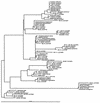Dynamics of fungal communities in bulk and maize rhizosphere soil in the tropics
- PMID: 12839741
- PMCID: PMC165189
- DOI: 10.1128/AEM.69.7.3758-3766.2003
Dynamics of fungal communities in bulk and maize rhizosphere soil in the tropics
Erratum in
- Appl Environ Microbiol. 2003 Sep;69(9):5737
Abstract
The fungal population dynamics in soil and in the rhizospheres of two maize cultivars grown in tropical soils were studied by a cultivation-independent analysis of directly extracted DNA to provide baseline data. Soil and rhizosphere samples were taken from six plots 20, 40, and 90 days after planting in two consecutive years. A 1.65-kb fragment of the 18S ribosomal DNA (rDNA) amplified from the total community DNA was analyzed by denaturing gradient gel electrophoresis (DGGE) and by cloning and sequencing. A rhizosphere effect was observed for fungal populations at all stages of plant development. In addition, pronounced changes in the composition of fungal communities during plant growth development were found by DGGE. Similar types of fingerprints were observed in two consecutive growth periods. No major differences were detected in the fungal patterns of the two cultivars. Direct cloning of 18S rDNA fragments amplified from soil or rhizosphere DNA resulted in 75 clones matching 12 dominant DGGE bands. The clones were characterized by their HinfI restriction patterns, and 39 different clones representing each group of restriction patterns were sequenced. The cloning and sequencing approach provided information on the phylogeny of dominant amplifiable fungal populations and allowed us to determine a number of fungal phylotypes that contribute to each of the dominant DGGE bands. Based on the sequence similarity of the 18S rDNA fragment with existing fungal isolates in the database, it was shown that the rhizospheres of young maize plants seemed to select the Ascomycetes order Pleosporales, while different members of the Ascomycetes and basidiomycetic yeast were detected in the rhizospheres of senescent maize plants.
Figures





Similar articles
-
Bacterial and fungal communities in bulk soil and rhizospheres of aluminum-tolerant and aluminum-sensitive maize (Zea mays L.) lines cultivated in unlimed and limed Cerrado soil.J Microbiol Biotechnol. 2008 May;18(5):805-14. J Microbiol Biotechnol. 2008. PMID: 18633275
-
Analysis of fungal diversity in the wheat rhizosphere by sequencing of cloned PCR-amplified genes encoding 18S rRNA and temperature gradient gel electrophoresis.Appl Environ Microbiol. 1999 Jun;65(6):2614-21. doi: 10.1128/AEM.65.6.2614-2621.1999. Appl Environ Microbiol. 1999. PMID: 10347051 Free PMC article.
-
Bulk and rhizosphere soil bacterial communities studied by denaturing gradient gel electrophoresis: plant-dependent enrichment and seasonal shifts revealed.Appl Environ Microbiol. 2001 Oct;67(10):4742-51. doi: 10.1128/AEM.67.10.4742-4751.2001. Appl Environ Microbiol. 2001. PMID: 11571180 Free PMC article.
-
Diversity and ecology of soil fungal communities: increased understanding through the application of molecular techniques.Environ Microbiol. 2004 Aug;6(8):769-79. doi: 10.1111/j.1462-2920.2004.00675.x. Environ Microbiol. 2004. PMID: 15250879 Review.
-
Botanical microbiomes on the cheap: Inexpensive molecular fingerprinting methods to study plant-associated communities of bacteria and fungi.Appl Plant Sci. 2020 Apr 15;8(4):e11334. doi: 10.1002/aps3.11334. eCollection 2020 Apr. Appl Plant Sci. 2020. PMID: 32351795 Free PMC article. Review.
Cited by
-
The response of soil organism communities to the application of the insecticide lindane in terrestrial model ecosystems.Ecotoxicology. 2013 Mar;22(2):339-62. doi: 10.1007/s10646-012-1030-0. Epub 2012 Dec 20. Ecotoxicology. 2013. PMID: 23264019
-
Temporal Dynamics of Rhizosphere Communities Across the Life Cycle of Panax notoginseng.Front Microbiol. 2022 Apr 1;13:853077. doi: 10.3389/fmicb.2022.853077. eCollection 2022. Front Microbiol. 2022. PMID: 35432289 Free PMC article.
-
Spatial variability of organic matter properties determines methane fluxes in a tropical forested peatland.Biogeochemistry. 2019;142(2):231-245. doi: 10.1007/s10533-018-0531-1. Epub 2018 Nov 26. Biogeochemistry. 2019. PMID: 30872875 Free PMC article.
-
Phylogenetic Relationship and Secondary Metabolite Production of Marine Fungi Producing the Cyclodepsipeptides Scopularide A and B.Mar Biotechnol (NY). 2016 Aug;18(4):466-74. doi: 10.1007/s10126-016-9707-7. Epub 2016 May 21. Mar Biotechnol (NY). 2016. PMID: 27209381
-
Illumina-based analysis of the rhizosphere microbial communities associated with healthy and wilted Lanzhou lily (Lilium davidii var. unicolor) plants grown in the field.World J Microbiol Biotechnol. 2016 Jun;32(6):95. doi: 10.1007/s11274-016-2051-2. Epub 2016 Apr 27. World J Microbiol Biotechnol. 2016. PMID: 27116961
References
-
- Bridge, P., and B. Spooner. 2001. Soil fungi: diversity and detection. Plant Soil 232:147-154.
-
- Brimecombe, M. J., F. A. De Leij, and J. M. Lynch. 2001. The effect of root exudates on rhizosphere microbial population, p. 95-140. In R. Pinton, Z. Varanini, and P. Nannipieri (ed.), The rhizosphere. Marcel Dekker, Inc., New York, N.Y.
Publication types
MeSH terms
Substances
Associated data
- Actions
- Actions
- Actions
- Actions
- Actions
- Actions
- Actions
- Actions
- Actions
- Actions
- Actions
- Actions
- Actions
- Actions
- Actions
- Actions
- Actions
- Actions
- Actions
- Actions
- Actions
- Actions
- Actions
- Actions
- Actions
- Actions
- Actions
- Actions
- Actions
- Actions
- Actions
- Actions
- Actions
- Actions
- Actions
- Actions
- Actions
- Actions
- Actions
- Actions
- Actions
LinkOut - more resources
Full Text Sources
Medical
Molecular Biology Databases

